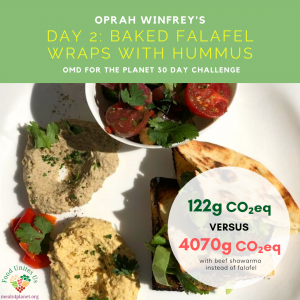This recipe is what Oprah had on Day 2 of her OMD for the Planet 30 day challenge. There is an incredibly large difference in carbon footprint between this dish (122 g CO2-eq per serving) and a comparison dish of a beef shawarma (4070 g CO2-eq per serving). One reason is that legumes (such as lentils, black beans, and chickpeas) have an especially low carbon footprint of 0.78 g CO2-eq per g of food due to the specialized bacteria living in their rootzone that can turn atmospheric nitrogen into a form that is available to the plant. Other crops may need added nitrogen fertilizer, which is very resource intensive to make. Another factor is that beef has an especially high carbon footprint, with estimates typically ranging from 26 to 40 g CO2-eq per g of food, due to the methane produced by the natural digestive process of cattle. Lamb and goat meat have similarly high carbon footprints for the same reason. For these calculations, we used the more conservative value of 26 g CO2eq per g.

The carbon savings here is about 3,950 g CO2eq per serving. Switching out the beef for falafel for just one meal saves the equivalent of an 18 mile drive in a 40 MPG car. If you did a similar switch each day, it would amount to saving the emissions from about 6,500 miles in the same car!
Another way to put the numbers in context is to think about the Paris Climate Accord. According to the targets agreed upon in Copenhagen, our country would need to reduce its carbon footprint by about 326 million metric tonnes per year. If we divide that by the people in the country and the days in a year, it’s about 2,700 g CO2eq per person per day!! So this recipe fulfills a personal pledge to the Paris Climate Accord for a day and then some! This calculation shows how much we can achieve through shifts in our diets away toward lower carbon footprint foods. To learn more about this see the Paris Climate Accord articles on this blog.
This recipe was created by Oprah’s chef Raymond Weber, and you can find all of the recipes online at oprahmag. Rachel Tsao used the Meals for the Planet calculator to find the numbers and made the infographic.
Carbon footprint data are from: Heller, M.C. and G.A. Keoleian. 2014. Greenhouse gas emission estimates of U.S. dietary choices and food loss. Journal of Industrial Ecology.


Recent Comments